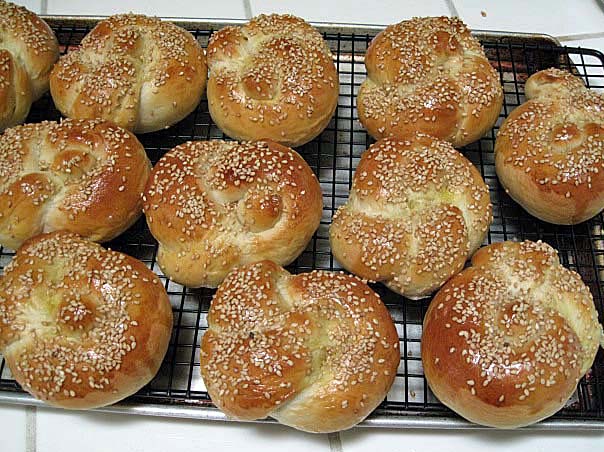Medium Vienna Dough for Soft Rolls
This formula is from
“Inside the Jewish Bakery,” by Stanley Ginsberg and Norman Berg
As Interpreted by David M. Snyder
May, 2020
For those who don’t know, Vienna Dough is an enriched dough that can be used for breads but is most often used for rolls - onion rolls, double knot rolls, pletzel, kaiser rolls and more. Besides differences in shaping, toppings and fillings, the various rolls differ in two respects: First, the dough can be more or less enriched with eggs, oil and sweeteners. Second, the shaped rolls can be more or less fully proofed. So, for example, rolls like onion pockets and knotted rolls are made with younger doughs (less proofed) and a sweeter dough. Kaiser rolls, where you want a less sweet dough, a crisper, thinner crust and less oven spring so the decorative shaping is maintained are proofed more fully.
It should be noted that all of these products were made without dairy and are therefore kosher with either dairy or meat meals.
This recipe is for a “medium vienna dough” that is ideal for knotted rolls and onion rolls. I use it for sandwich rolls. It makes a dozen 3 oz rolls.
Ingredient | Volume | Grams | Bakers Percentage |
Bread flour | 4 1/2 cups | 620 | 100 |
Water | 1 1/4 cups | 280 | 45 |
Veg. oil | 2 Tbs | 30 | 5 |
Egg | 1 large + 1 for brushing | 50 | 8 |
Sugar | 3 Tbs | 40 | 6 |
Dry or liquid malt | 1 Tbs | 20 | 3 |
Instant yeast | 5 tsp | 20 | 3 |
Salt | 1 1/2 tsp | 10 | 2 |
Seeds for topping the rolls | | | |
Note: I generally use all purpose flout with 11.7% protein. If you use a high gluten flour or if you substitute whole wheat flour for some of the bread flour, you will have to increase the water slightly to achieve the expected dough consistency which should be slightly tacky but not sticky.
If you use dry malt, treat it as a dry ingredient. If you use malt syrup, dissolve it in the water and then add the other wet ingredients.
Procedures
1. Place the dry ingredients except the salt in the bowl of a stand mixer. Whisk them or use the paddle attachment to mix them together.
2. Mix the wet ingredients in a medium bowl.
3. Add the wet ingredients to the mixer bowl and mix with the paddle attachment at slow speed until all the flour is moistened. Add the salt and continue mixing for another minute.
4. Switch to the dough hook and mix at Speed 2 (on a KitchenAid Stand Mixer) until a medium gluten window is achieved (about 10 minutes).
5. Transfer the dough to the board and form a ball. Place the dough in a lightly oiled large bowl that can allow doubling of the dough volume. Cover the bowl.
6. Bulk ferment the dough in a warm place until it has doubled in volume. (45-60 minutes).
7. Transfer the dough to a lightly floured board. Divide it into 12 equal pieces of about 3 oz. each.
8. Form the pieces into balls, cover them with a towel and let them rest for 15-20 minutes.
9. Shape the pieces as desired - flat disks for hamburger buns, long rolls for sausages, ropes to make knotted rolls, etc.
10. Places the formed rolls onto baking sheets and cover them. (I use quarter sheet pans which hold 6 rolls each and put these in plastic bakery bags for proofing.)
11. Pre-heat your oven to 350ºF.
12. Mix an egg with a tsp of water to glaze the rolls. Get out any seeds you want to put on them.
13. Let the rolls proof 3/4 of the way. (If you poke a finger in one, the hole should fill in very slowly.)
14. Brush the rolls with the egg wash. Sprinkle each roll with seeds (optional).
15. Bake until lightly browned and fully baked. (12-15 minutes or a bit longer, depending on your oven).
16. Cool on a rack completely before serving.



These rolls freeze well. I wrap each in cling wrap and place them in a plastic bakery bag with a tie. Thaw in a 375ºF oven for about 7 minutes.
Enjoy
David